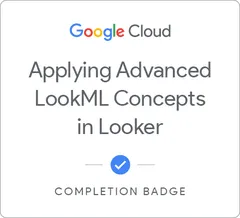
Applying Advanced LookML Concepts in Looker 
Discover the fundamentals of Applying Advanced LookML Concepts in Looker ▼
ADVERTISEMENT
Course Feature
![]() Cost:
Cost:
Free
![]() Provider:
Provider:
Qwiklabs
![]() Certificate:
Certificate:
Free Certification
![]() Language:
Language:
English
![]() Start Date:
Start Date:
On-Demand
Course Overview
❗The content presented here is sourced directly from Qwiklabs platform. For comprehensive course details, including enrollment information, simply click on the 'Go to class' link on our website.
Updated in [May 19th, 2023]
This course, Applying Advanced LookML Concepts in Looker, provides learners with the opportunity to gain hands-on experience applying advanced LookML concepts in Looker. Learners will be guided through the process of using Liquid to customize and create dynamic dimensions and measures, creating dynamic SQL derived tables and customized native derived tables, and using extends to modularize their LookML code. By the end of the course, learners will have a better understanding of how to use advanced LookML concepts to create powerful and dynamic data models.
[Applications]
After completing this course, users should be able to apply the advanced LookML concepts they have learned to their own Looker projects. They should be able to use Liquid to customize and create dynamic dimensions and measures, create dynamic SQL derived tables and customized native derived tables, and use extends to modularize their LookML code. Additionally, users should be able to use the LookML IDE to debug their LookML code and ensure that it is functioning as expected. Finally, users should be able to use the Looker API to automate their LookML development process.
[Career Paths]
1. Data Analyst: Data Analysts are responsible for collecting, organizing, and analyzing data to help inform business decisions. They use a variety of tools and techniques to uncover trends and insights in data, and communicate their findings to stakeholders. With the skills acquired in this course, Data Analysts can use Looker to create dynamic and customized data models to better understand their data and make more informed decisions.
2. Business Intelligence Developer: Business Intelligence Developers are responsible for designing and developing data models and reports to help organizations make better decisions. With the skills acquired in this course, Business Intelligence Developers can use Looker to create dynamic and customized data models to better understand their data and create more powerful reports.
3. Data Scientist: Data Scientists are responsible for using data to solve complex problems and uncover insights. With the skills acquired in this course, Data Scientists can use Looker to create dynamic and customized data models to better understand their data and uncover deeper insights.
4. Data Engineer: Data Engineers are responsible for designing, building, and maintaining data pipelines and data warehouses. With the skills acquired in this course, Data Engineers can use Looker to create dynamic and customized data models to better understand their data and create more efficient data pipelines.
[Education Paths]
1. Bachelor of Science in Computer Science: This degree path focuses on the fundamentals of computer science, such as programming, algorithms, data structures, and software engineering. It also covers topics such as artificial intelligence, machine learning, and computer networks. With the increasing demand for data-driven insights, this degree path is becoming increasingly popular and is a great way to gain the skills needed to work with LookML.
2. Master of Science in Data Science: This degree path focuses on the application of data science techniques to solve real-world problems. It covers topics such as data mining, machine learning, and predictive analytics. With the increasing demand for data-driven insights, this degree path is becoming increasingly popular and is a great way to gain the skills needed to work with LookML.
3. Master of Science in Business Analytics: This degree path focuses on the application of data science techniques to business problems. It covers topics such as data mining, machine learning, and predictive analytics. With the increasing demand for data-driven insights, this degree path is becoming increasingly popular and is a great way to gain the skills needed to work with LookML.
4. Master of Science in Artificial Intelligence: This degree path focuses on the application of artificial intelligence techniques to solve real-world problems. It covers topics such as machine learning, natural language processing, and computer vision. With the increasing demand for data-driven insights, this degree path is becoming increasingly popular and is a great way to gain the skills needed to work with LookML.
Course Provider

Provider Qwiklabs's Stats at AZClass
Discussion and Reviews
0.0 (Based on 0 reviews)
Explore Similar Online Courses

iOS Developer Online Course

Learn Nursing and Patient Care - Diploma Course

Python for Informatics: Exploring Information

Social Network Analysis

Introduction to Systematic Review and Meta-Analysis

The Analytics Edge

DCO042 - Python For Informatics

Causal Diagrams: Draw Your Assumptions Before Your Conclusions

Whole genome sequencing of bacterial genomes - tools and applications

Serverless Data Processing with Dataflow: Develop Pipelines

Serverless Data Processing with Dataflow: Foundations


Start your review of Applying Advanced LookML Concepts in Looker